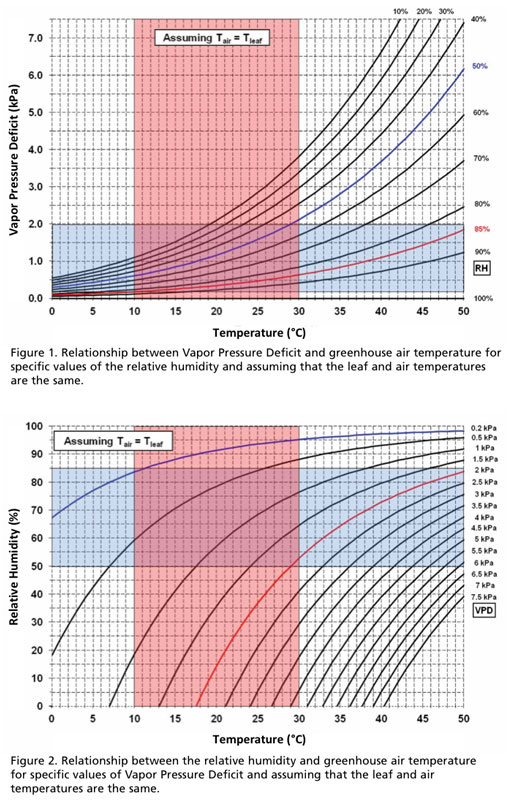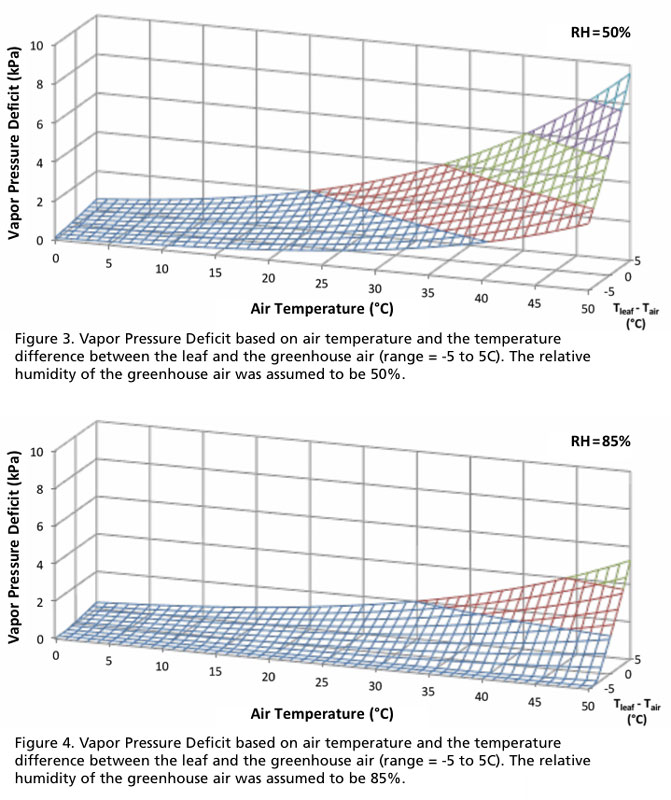11/1/2018
Vapor Pressure Deficit Revisited
By Tim Shelford, Tom Manning & A.J. Both

You’ve probably heard it before: When it comes to assessing the amount of moisture in the air, it’s better to use something we call vapor pressure deficit than the relative humidity. So why is that? Isn’t it more difficult to determine the vapor pressure deficit (VPD) and how can it be used to improve crop growth and development?
In order to maintain the optimum growing conditions in greenhouse environments, growers rely mainly on air temperature and light measurements, but occasionally they also measure other parameters, including the (relative) humidity and the carbon dioxide concentration. Additional parameters can also be evaluated (e.g., soil temperature and moisture), as well as the operating status of a variety of equipment. Here, we’ll focus only on the air temperature and its (relative) humidity.
Air and pressure
Air consists of several gasses, including Nitrogen (almost 80%), Oxygen (around 20%), a range of trace gasses, including carbon dioxide, (around 0.04%), and water vapor. The molecules of these constituents vibrate randomly depending on the air temperature (the higher the temperature, the more vigorous the vibrations) and this vibration causes a force (pressure) on the surroundings.
The vibrations of the molecules of each constituent contribute to the overall air pressure and we can define these contributions by the individual constituents as partial pressures. Thus, the total air pressure (as measured with a barometer) is the sum of a number of partial pressures that are determined by the amount (number of molecules) of each constituent and the air temperature.
The amount of water vapor in the air can vary: Heating the air typically reduces the humidity (think of dry desert heat), and humid and hot summer air can make conditions rather unbearable (makes it difficult for us to lose heat by perspiration). Such hot-and-dry or hot-and-humid conditions can cause problems for plants, too—when the air is dry, plants lose more water (until the water uptake by the roots can no longer keep up with the transpiration rate from the leaves). And when the humidity is high, plants find it more difficult to transpire water from their leaves, thus reducing their own cooling capacity. Transpiration requires heat that’s drawn from the plant during this process.
Measuring temperature
So, in order to assess the suitability of the key conditions of the air for plant growth, we need to measure the temperature and humidity. Measuring the temperature is straight-forward and there are several devices that can provide accurate readings. However, measuring the humidity is a little more complicated.
We often report the so-called relative humidity, which can be defined as the ratio of the partial water vapor pressure and the saturated water vapor pressure. The latter pressure represents the maximum number of water molecules the air can hold at a particular temperature. Mist is a good example of air reaching the saturation vapor pressure: as air is cooled, it will reach a temperature at which it can hold no more water vapor and any access water vapor will condense into water droplets. We call this temperature at which condensation occurs the dew point temperature. Note that at the dew point temperature the relative humidity is always 100%.
 So far so good, but there’s one challenge: the relative humidity depends on the air temperature. In other words, as the temperature changes, so does the relative humidity. They typically move in opposite directions—as the temperature increases, the relative humidity drops and vice versa.
So far so good, but there’s one challenge: the relative humidity depends on the air temperature. In other words, as the temperature changes, so does the relative humidity. They typically move in opposite directions—as the temperature increases, the relative humidity drops and vice versa.
In addition, different temperature changes can result in the same change in relative humidity, while the (absolute) humidity conditions associated with those temperature changes are markedly different. A plant going through such temperature changes may experience very different air humidity conditions, while our relative humidity measurements would imply that the changes are similar. And this is precisely why you’ve heard people say that using the relative humidity isn’t the right approach.
And so using VPD gives us a better idea what the plant is experiencing in terms of the humidity conditions. VPD represents the difference in water vapor pressure between the conditions of the air and the conditions of the leaf (and by conditions, we mean the temperature). That means that we need to measure both the temperature of the air and the temperature of the leaf in order to determine the VPD.
Again, we know how to measure air temperature, but measuring the leaf temperature isn’t something growers do regularly. One approach is to attach a small thermocouple wire to the (bottom of the) leaf, but since leaves often move (a little) and expand as they grow, it’s not always easy to ensure good contact between the sensor and the leaf. An alternative is to use an infrared thermometer placed some distance above the crop so it can measure the (average) canopy temperature across a certain surface area.
The vapor pressure of the leaf is always considered to be the saturation vapor pressure because we’re evaluating the conditions just inside the leaf stomates. Due to the proximity to unprotected internal leaf tissue, the small air volumes inside of the stomatal cavities are considered to be saturated. So once we measure the leaf temperature, we can use an equation to determine the saturation vapor pressure of the air inside the stomatal cavities.
Next, using the temperature and relative humidity measurement of the greenhouse air, we can determine the partial vapor pressure of the air outside the leaf. A simple subtraction will then result in the VPD. So we still use the relative humidity of the greenhouse air to complete the calculations, but we don’t use it to assess the humidity conditions that impact the plants.
Sometimes, it’s not feasible to determine the leaf temperature (e.g., when we don’t have an infrared temperature sensor). In that case, we can assume that the leaf temperature equals the greenhouse air temperature. While this assumption makes it possible to calculate the (approximate) VPD, we run the risk of making a (small) calculation error. For example, when leaves are transpiring water, they tend to be cooler than the surrounding air because heat is extracted from the leaves during the evaporation process. So while not a perfect situation, when we don’t know the leaf temperature, we can still use the concept of VPD by assuming that the air temperature and the leaf temperature are the same.
We can use graphs to determine the VPD (Figures 1 and 2) after we’ve measured the temperature and relative humidity. Note that for these graphs, we assumed that the air temperature and leaf temperature are the same. But if we also know the leaf temperature, we can use a similar approach to determine the VPD (Figures 3 and 4). Most crops perform best when exposed to temperature and relative humidity conditions ranging between 50 and 86F (10 and 30C) and 50% and 85%, respectively.
In addition, optimum VPD values range between 0.2 and 2.0 kPa (1 kPa = 0.145 psi). These ranges are just guidelines and can be exceeded under certain conditions, but they provide a way to assess whether adjustments of the environmental conditions are beneficial, and if so, how large these adjustments need to be.
In conclusion, the vapor pressure deficit is a better measurement to assess the plant’s ability to move water through the stomates than the relative humidity. It can be estimated from measurements of the temperature and relative humidity of the surrounding air or it can be precisely calculated when we also measure the leaf (canopy) temperature.
Growers can use VPD measurements to adjust their control strategy so that plants are exposed to the most favorable environmental conditions. Once the target VPD is known, the most cost-effective adjustment of temperature and/or the relative humidity can be implemented to reach the target VPD value. Growers are encouraged to consult with plant scientists about optimum VPD values for their crops.
Tim Shelford is a Research Associate, Tom Manning is a Project Engineer, and A.J. Both (both@sebs.rutgers.edu) is a Professor and Extension Specialist at Rutgers University in New Brunswick, New Jersey.
Importance of High RH and Low VPD During Periods with High Solar Radiation
During low RH conditions in combination with air movement (e.g., from HAF fans), plant transpiration can be substantial. When, in addition, the incoming solar radiation is high, transpiration can exceed the capacity of the plant to uptake water. As a result, stomates close (or reduce their combined opening area), transpiration declines and the VPD remains high.
If during these conditions the VPD remains higher than 1.5 to 2.0 kPa, the plant is no longer able to adequately regulate water loss and could experience stress conditions (too much water loss). So it’s not the VPD, but the regulation of the combined stomatal opening area that determines plant transpiration. By regulating the stomatal opening, the plant maintains an optimum temperature difference between the leaf and the greenhouse air. A high leaf temperature is therefore typically accompanied by a high VPD.
A relatively simple way to reduce plant transpiration during high solar radiation is to increase the RH. The leaf can never get colder than the wet bulb temperature, which under high RH conditions is only a few degrees below the air temperature. This small temperature difference ensures that little energy is lost due to transpiration.
For the plant to remove energy (by convection), only a small leaf temperature rise is necessary relative to the air temperature. This can be accomplished by a small adjustment of the combined stomatal opening area. In other words, the plant is able to balance transpiration and water uptake under relatively low VPD conditions by regulating the stomatal openings. As a result, CO2 uptake (and therefore photosynthesis) can continue at a higher rate under conditions of high solar radiation.
Translated from “Het Nieuwe Telen” (The Next Generation Growing System) authored by P.A.M. Geelen, J.O. Voogt, and P.A. van Weel (2015). Available at: www.kasalsenergiebron.nl/besparen/het-nieuwe-telen (in Dutch). GT